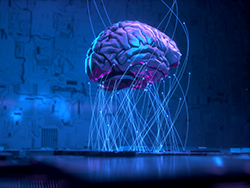Human/Artificial Intelligence
Complementarity
 Artificial Intelligence has become an ubiquitous and towering facet of our modern cyber-physical lives. The average person is “touched” by some form of AI on both cognitive and physical levels
multiple times daily. Generative AI has drawn much public attention, but many other forms of AI exist to facilitate our daily functioning and problem-solving. Our interaction with these embedded
AIs or algorithms is often unperceived as they are embedded in cyber-physical systems.
Artificial Intelligence has become an ubiquitous and towering facet of our modern cyber-physical lives. The average person is “touched” by some form of AI on both cognitive and physical levels
multiple times daily. Generative AI has drawn much public attention, but many other forms of AI exist to facilitate our daily functioning and problem-solving. Our interaction with these embedded
AIs or algorithms is often unperceived as they are embedded in cyber-physical systems.
We stand at the most amazing and potentially most impactful inflection point in history, as never before has humanity created a technology that offers a nearly symbiotic relationship with its user. New models of human/AI augmentation will power the advanced economies of tomorrow and enable us to both solve many of today's unsolvable problems and innovate in ways never imagined. Yet despite the awe created by generative AI and the obvious opportunities of the overall technology, there are fundamental flaws with our conceptualization and understanding of AI that will prevent its applications within organizational environments from achieving maximum benefits.
A flawed conceptualization
The largest gains from AI will come from novel Human/AI workplace models designed for problem-solving and innovation. Among the a priori determinants for success in creating new models of Humans & AI is an accurate conceptual framing of Human/AI complementarity.
AI is not artificial intelligence as it currently exists in form and function. AI today does not resemble Hollywood's vision nor recollect or solve problems like the human brain. AI is not
intelligent; it does not possess knowledge or understanding as our brains do. Nor do Artificial Neural Nets (ANNs) represent the brain's structure and, more specifically, the brain region
responsible for both memory and higher-order functions – the neocortex. How our brain learns, remembers, and solves problems vastly and categorically differs from how an AI learns from a Large
Language Model (LLM)
Today’s AI can more aptly be described as advanced information processing, synthesizing, and production systems vs. true general-purpose intelligence. A prime example of the difference between AI and the human brain is their categorically different problem-solving approaches. AI attempts to solve problems through probabilities, correlations, likeness, and other complex equations, often taking billions or trillions of “steps.” Our brains solve problems by accessing memories, understanding relationships of variables, and time-sequenced occurrences in relation to the variables of the current situation. The brain does this utilizing a series of reference frames and associated emotional correlations, such as trust, perception, and beliefs, and it does this in 100 steps or less – never more. In short, our brains are intrinsically different yet uniquely complementary in that when we pair the human brain with AI, we have the most powerful combination problem-solving construct ever known in human history. This complementarity through augmentation will propel problem-solving, innovation, and organizational valuation and wealth for decades.
The key - uniquely complementary
We have entered the Age of Augmentation. This age is unparalleled in human history due to the uniquely complementary nature of humans and AI. Neither the Industrial nor Information Ages presented us with today's unique opportunities to create value at speed and scale. To do so will require more than a superficial understanding of how to pair humans and AI to achieve maximum results.
Central to achieving the most from integrating AI into the workplace is avoiding a singular focus on the technology while ignoring the human factors. Virtually every firm has a Digital Transformation (DX) strategy and implementation plan, few have a Human Factors Analysis to go along with the technology artifacts.
A central key to success will be to develop Human/AI capabilities through a deep understanding of how our human brain utilizes and trusts data/technology, makes associations, solves problems, remembers, and much more. It was a fool's errand to simply state “we want data-driven decision-making in the DNA of the firm,” and hope people utilize data in their decision-making processes. For future success, we need a deep understanding of how the brain makes decisions with data, makes errors, trusts, and how our memory functions. This scientific foundation will enable the design of novel models of people and technology working together in truly complementary ways.
Many a wise person has said the “devil is in the details,” which remains true as we embark on what is likely to be a never-ending journey of creating Human/AI working models. One aspect is enabling functions by creating interaction and user interfaces that enable the brain and computers to do what they do well while complementing the other's weaknesses. Walt Mossberg, the noted technology writer, prophetically stated, “Tech was once always in your way. Soon, it will be almost invisible.” Walt was correct in his assertion that keyboards, mouses, and screens pose some difficulty for the brain to navigate in its desire to create Understanding. We must purposefully evolve the interaction of human operators and AI to be human-centric and as natural as possible. This also means evolving our use of two-dimensional representations, which present data/information contrary to the brain's operation.
It is not well understood by those building decision-support systems that the brain seeks understanding in two ways, each specific to a hemisphere. First is confirmation of what it believes to be
true with little context and great confidence; second is seeking



















